Lebanese Tabbouleh Salad
Updated Oct 18, 2025
This traditional Lebanese Tabbouleh Salad recipe is a healthy vegan Mediterranean appetizer made with bulgur, parsley, mint and vegetables.
This post may contain affiliate links. Please read our disclosure policy.
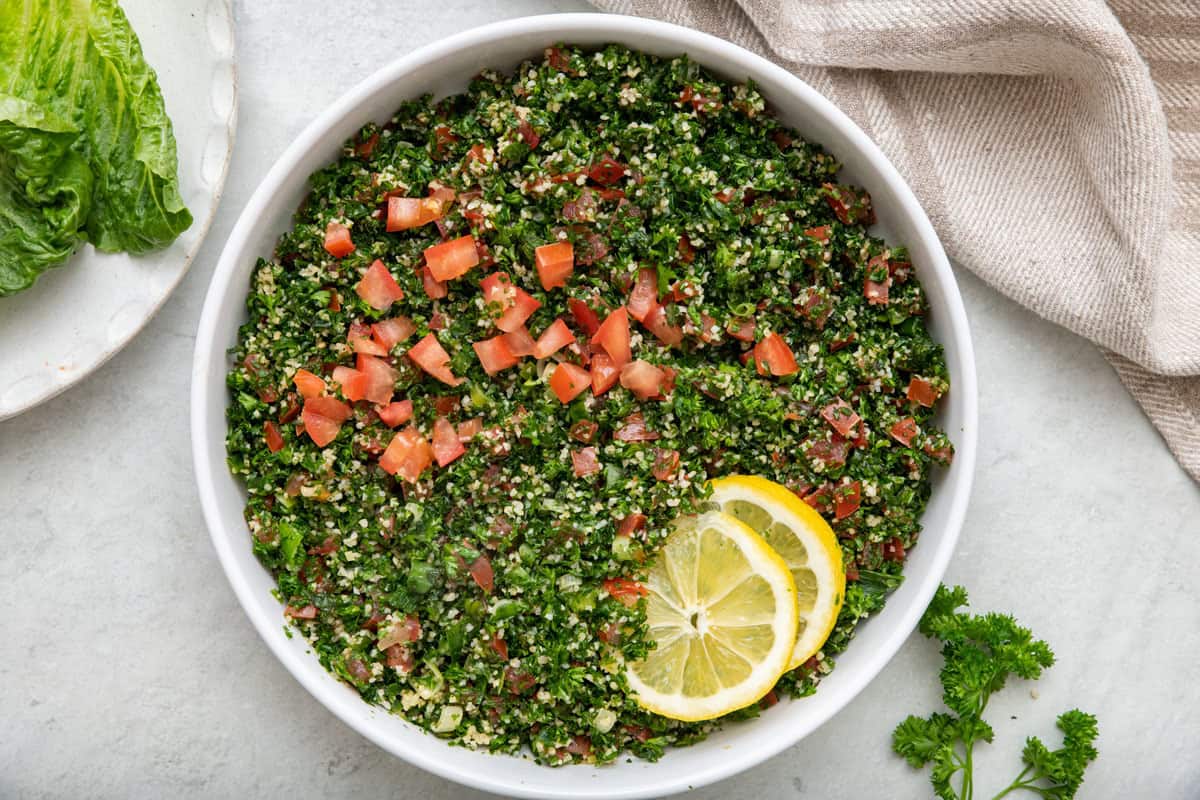
Jump to Section
The Best Authentic Tabbouleh

Tabbouleh salad along with fattoush salad are the most popular two salads in Lebanon, which is where tabbouleh (also spelled tabouli) most likely originated from. My parents are both Lebanese, so you can imagine I’ve grown up eating a lot of tabbouleh in my life. And because of that, I’ve learned how to make the best tabbouleh recipe!
Traditional tabbouleh is a fresh and super flavorful Middle Eastern salad that’s mostly made with parsley! The other ingredients are tomatoes, bulgur wheat, green onions and mint – all finely chopped and tossed with olive oil and lemon juice! It’s a must-have whenever I’m preparing a Lebanese spread for guests, and especially in the summer with grilled meats like shish tawook, kafta and beef kabobs.

I don’t usually comment on recipes, but this one is the real deal — it turned out wonderful and exactly like what I used to get in my favorite Lebanese restaurant. Soaking the bulgur in the dressing is genius. Definitely a keeper and can’t wait to try other recipes on this site. Thank you! – Rebecca
Tabbouleh Ingredients
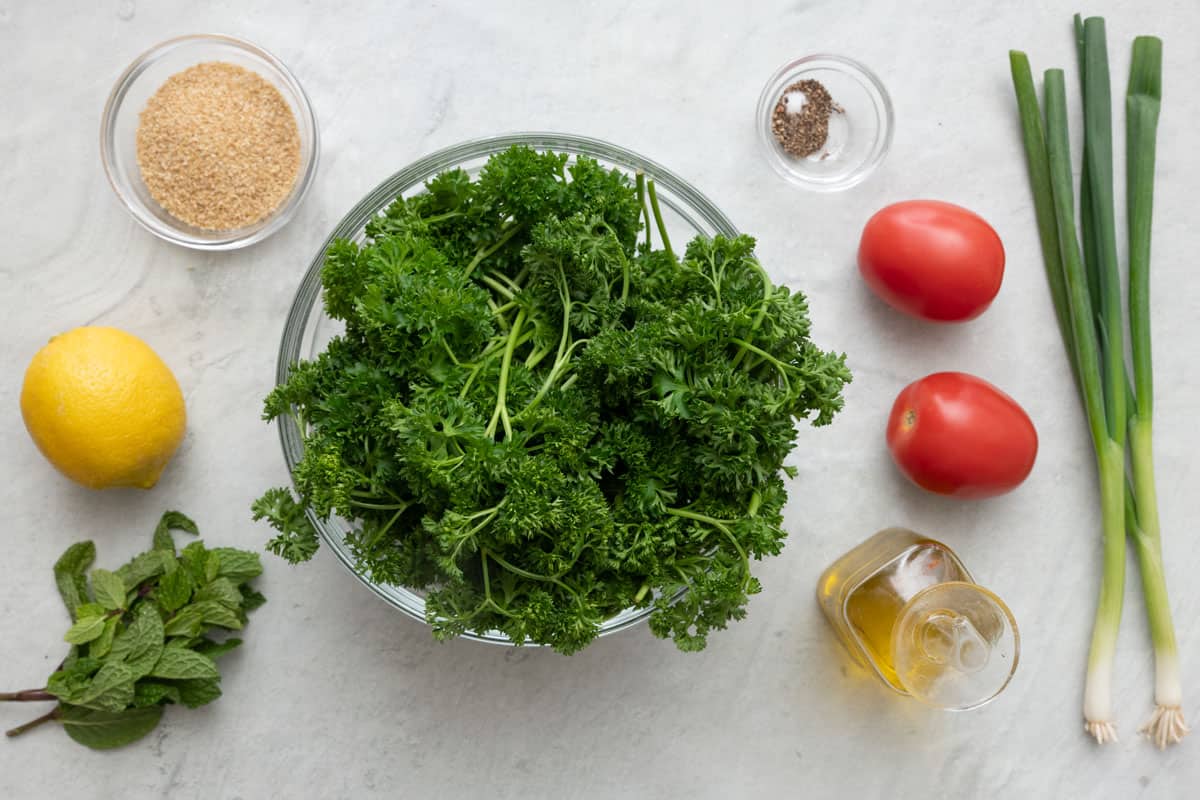
- Parsley: This makes up the bulk of the recipe, and traditionally it’s made with flat leaf Italian parsley because that’s what’s mostly grown in Lebanon, but curly parsley adds more volume and it’s easier to chop without wilting so I prefer curly. Make sure to wash the parsley with cold water, and dry it well with a salad spinner. If you have time, wash and dry the parsley a day in advance to minimize the moisture on it before chopping. Don’t include the parsley stems.
- Bulgur: Use extra fine bulgur – the smallest you can find! Bulgur is sold in four numbered grind sizes. You want to look for #1, which is the smallest grind. It looks like couscous, and it’s what we use in a traditional tabbouleh salad. There is no need to cook this bulgur; you’ll just soak it in liquid to make it tender.
- Tomatoes: Use firm and ripe tomatoes, and if they are too juicy, you can remove their core before dicing and save them for a soup.
- Green onions: Use the entire green onion parts – white and green. You can substitute white or red onions, but they’ll have a stronger taste.
- Mint: Freshly chopped mint is optional but adds so much flavor. You can substitute the ¼ cup of chopped mint with ½ – 1 teaspoon of dried mint.
- Olive Oil: Go for cold-pressed extra virgin olive oil for the best flavor.
- Lemon Juice: Freshly squeezed please. 🙂
- Seasoning: Just salt and pepper.
I was nervous to make tabbouleh for the first time at home, but wow this recipe is amazing! tastes just like how my teta used to make it. – KP
Recipe Video Tutorial
How to Make Authentic Tabbouleh
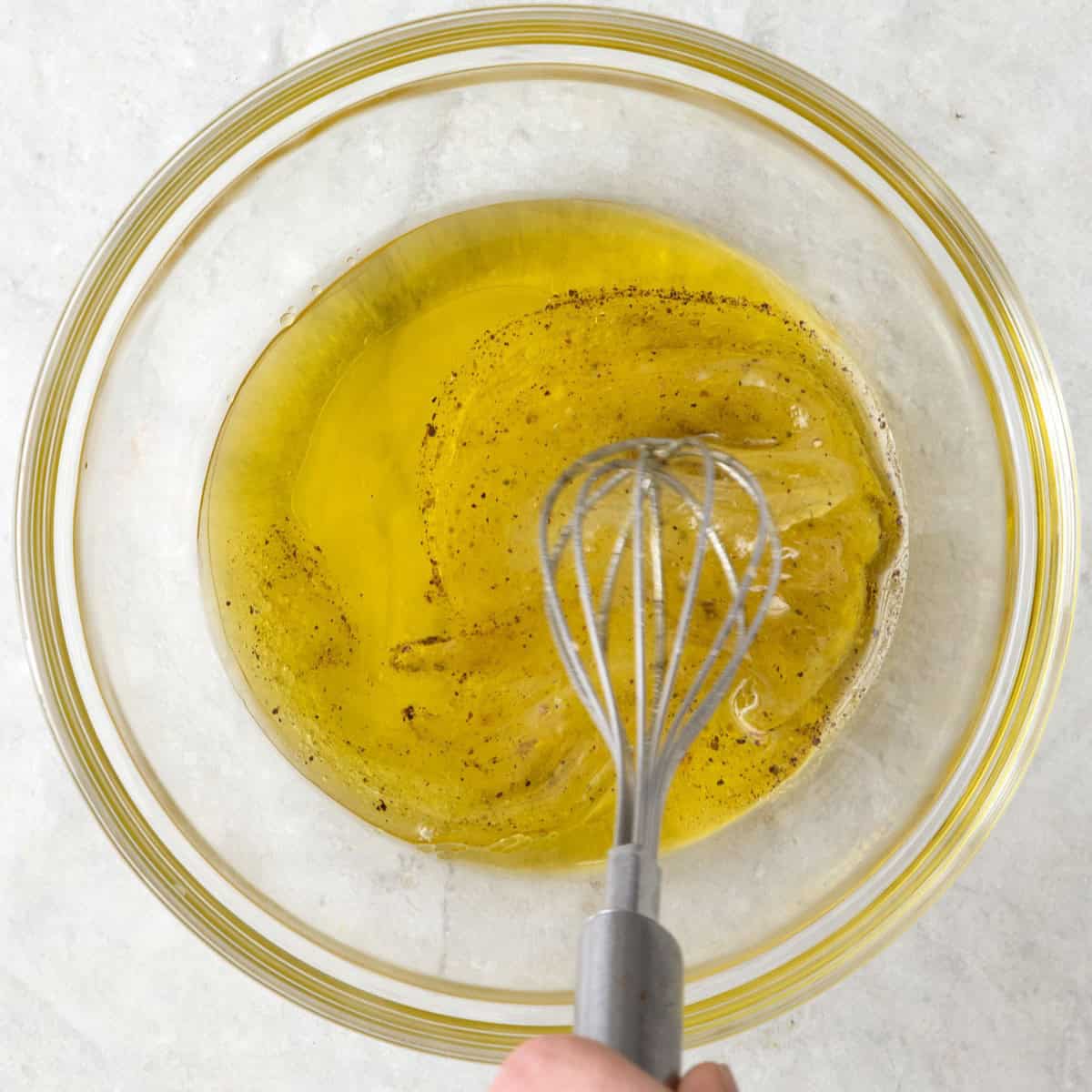
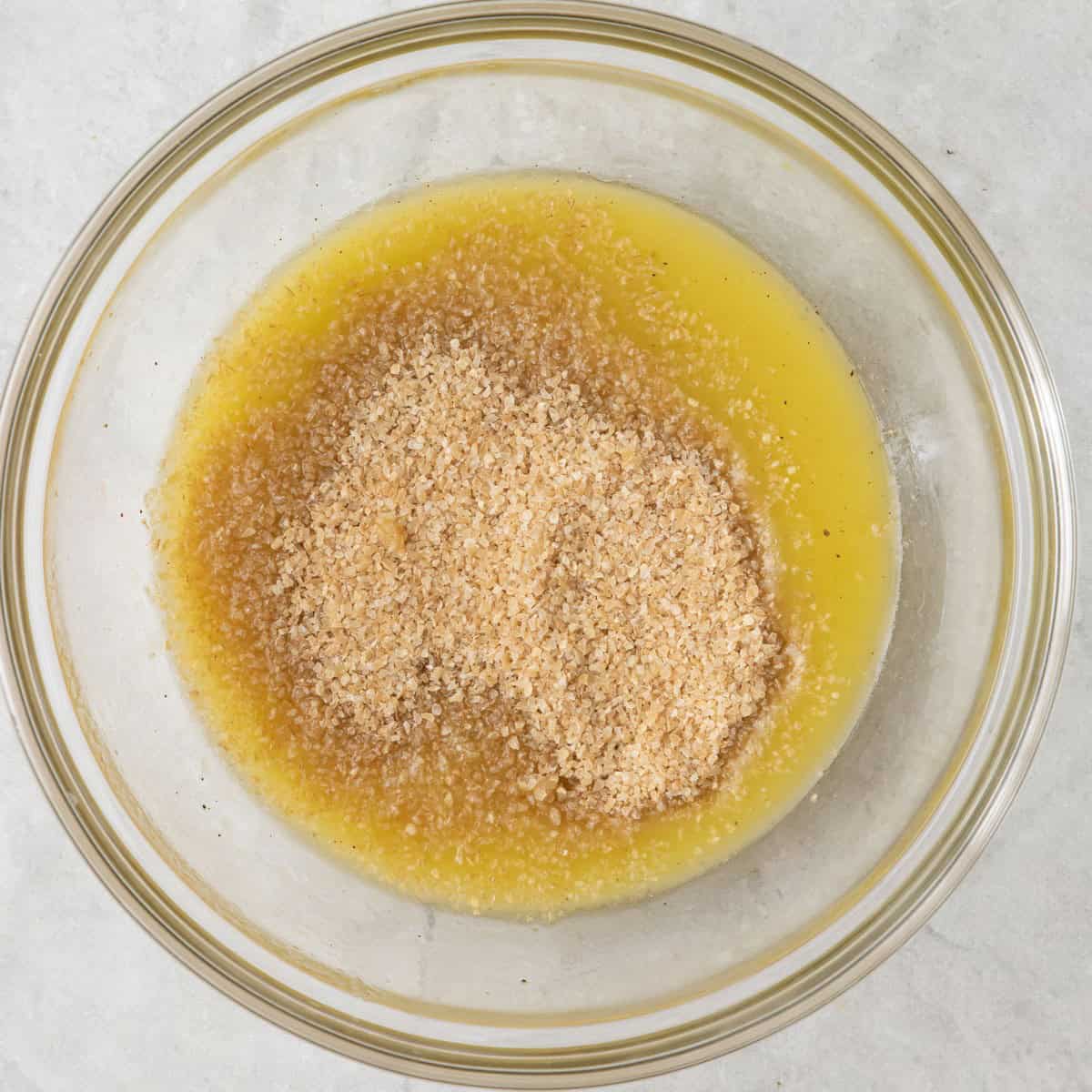
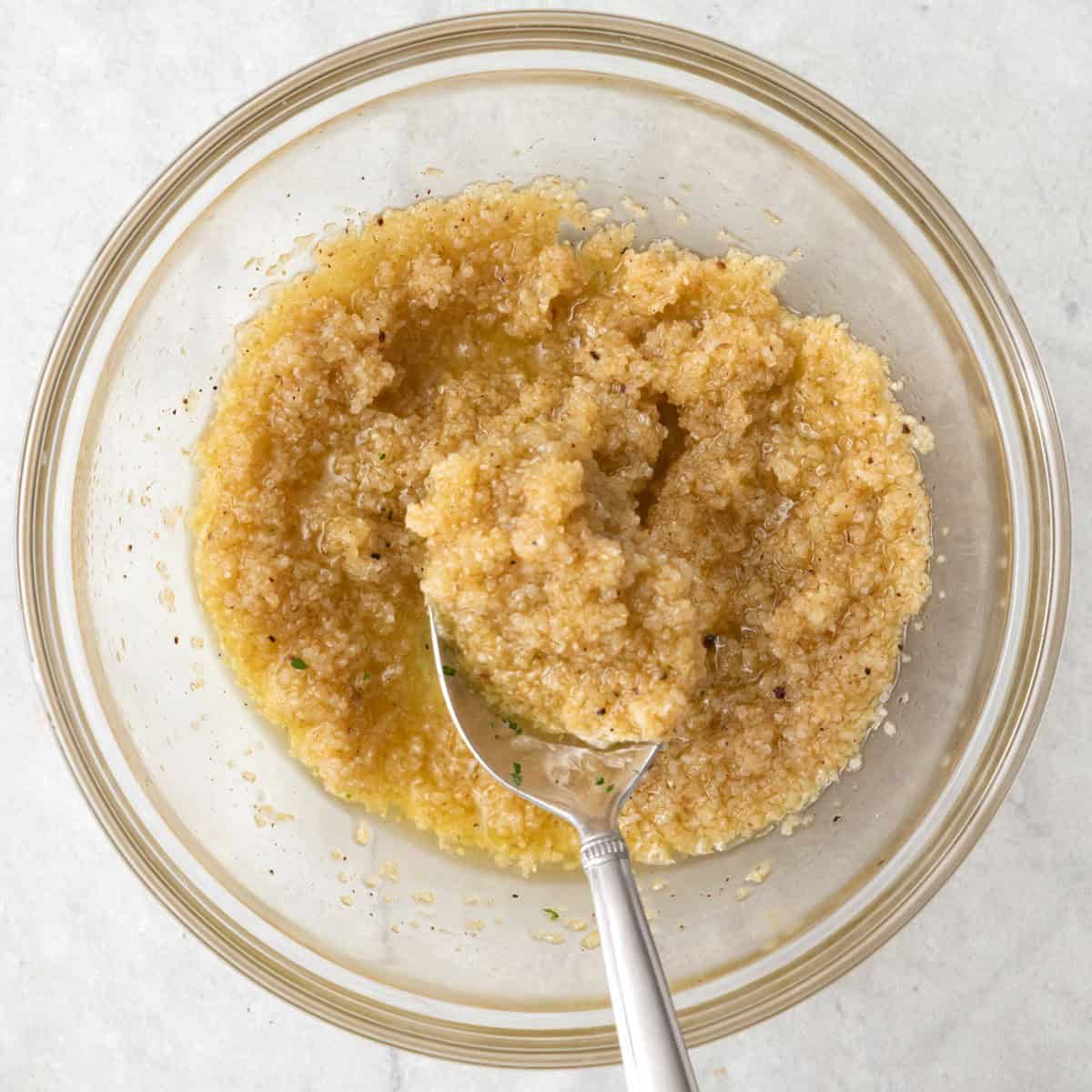
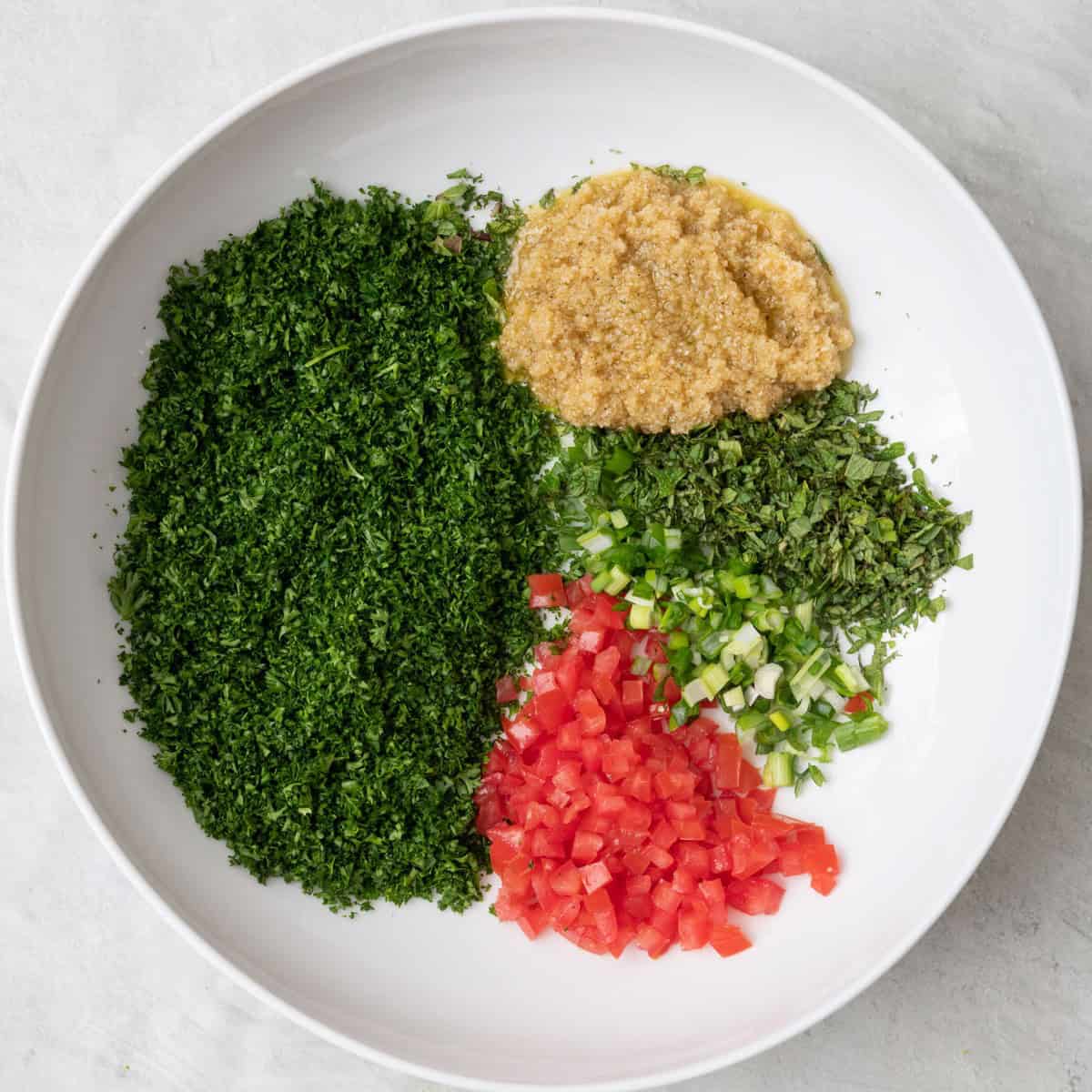
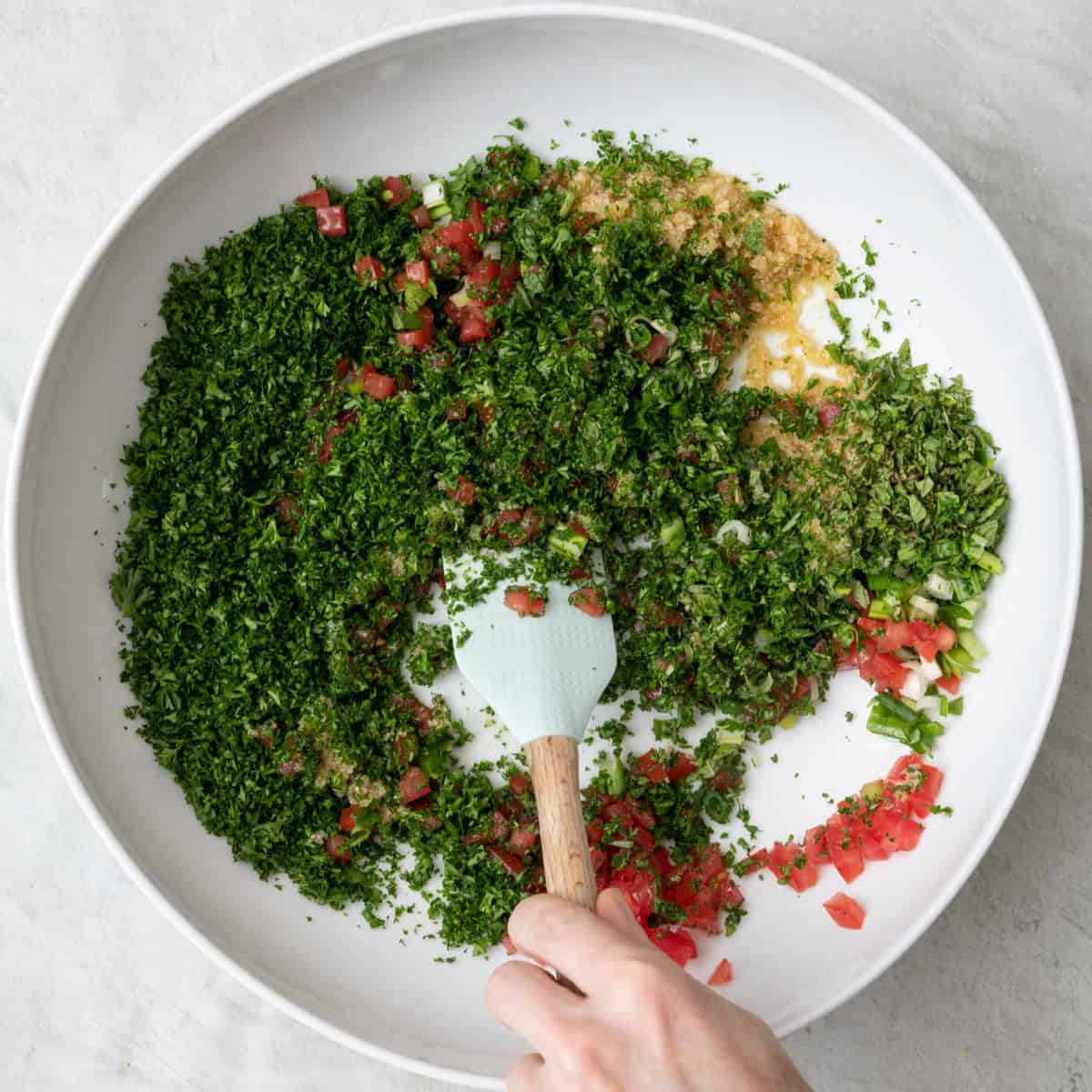
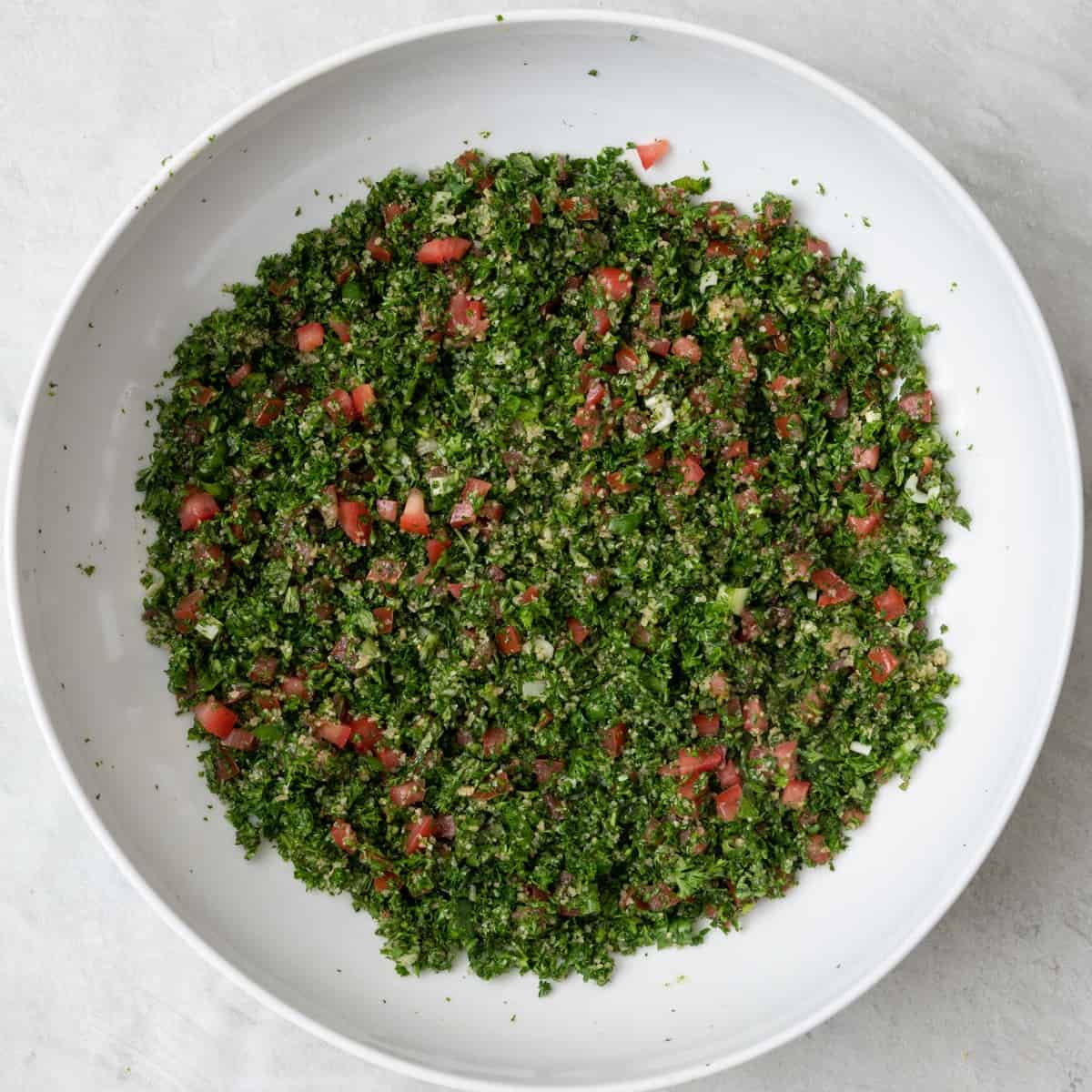
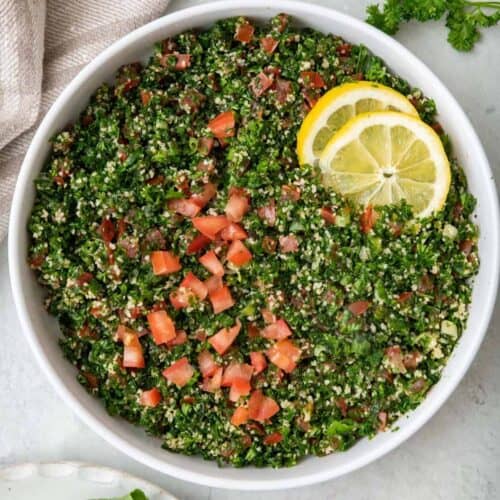
Tabbouleh Salad Recipe
Video
Ingredients
- ⅓ cup extra-virgin olive oil
- 3 tablespoons lemon juice
- ¼ teaspoon salt
- ¼ teaspoon black pepper
- ¼ cup fine #1 bulgur wheat
- 3 bunches fresh curly parsley finely chopped (about 3 packed cups)
- 2 firm tomatoes finely chopped
- 2 green onions finely chopped
- ¼ cup fresh mint finely chopped
Instructions
- Whisk the olive oil, lemon juice, salt, and pepper in a large bowl until well combined. Stir in the bulgur. Let the grains soak up the dressing until they are plump and most of the moisture is absorbed for about 20 to 30 minutes.
- Meanwhile, add the parsley, tomatoes, green onions, and mint to one side of the large bowl with the bulgur, but don’t mix yet.
- When the bulgur is plump, and the lemon-olive oil mixture is mostly absorbed, stir everything together until well combined. Serve at room temperature or chilled from the fridge.
Notes
Nutrition
Nutrition information provided is an estimate. It will vary based on cooking method and specific ingredients used.
Recipe Variations
- Quinoa Tabbouleh: For a gluten-free alternative or a different twist on texture, you can use cooked quinoa instead of bulgur. Grab my tutorial for how to cook quinoa for the best texture.
- Kale Tabbouleh Salad: Kale is more mild than parsley so the taste is more palatable for most people. And, when you chop it finely, it looks like parsley!
- Cauliflower Tabbouleh: This is a grain-free low-carb twist made with grated cauliflower or cauliflower rice.
Recipe Tips
- Chop finely: Presentation is everything with tabbouleh, so use a sharp knife and take your time to chop the parsley, tomatoes, green onions and mint finely. Don’t use a food processor because it will wilt the parsley and ruin the texture of the salad.
- Use the correct bulgur: Look for #1 extra fine bulgur. The focus of the salad is on the parsley, not the bulgur, so you want fine bulgur that incorporates easily into the salad without standing out. The bulgur should require no cooking.
- Soak the bulgur in the dressing: I learned this tip from my mother-in-law and it’s genius. Normally, you’d soak bulgur in hot water for 5 minutes to plump it. But if you soak in the the olive oil and lemon juice dressing, it has the same effect of rehydrating the dried cooked fine bulgur but also making the salad more tasty because there’s no risk of watering down the flavor.
- Use fine tomatoes: You want them to be ripe for flavor’s sake, but firm so they don’t release too much juice. If you have time, core the tomatoes to remove the watery interior and use that for soups and then chop the exterior. You can also just use a mesh colander to drain the liquids from chopped (uncored) tomatoes.
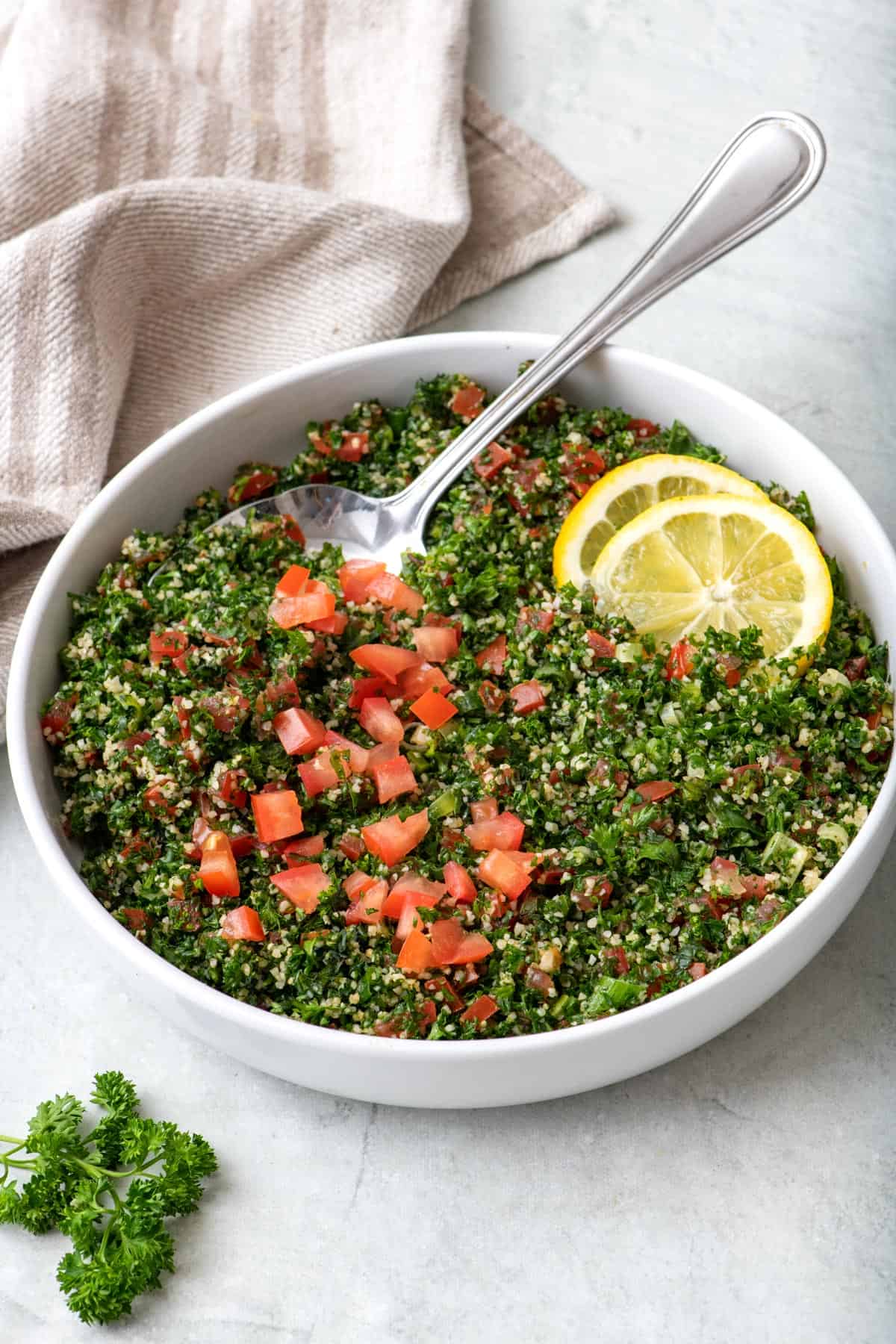
Serving Ideas
- On its own as a salad or served with lettuce boats as an appetizer.
- As part of a Lebanese appetizer spread or Middle Eastern Mezza with Stuffed Grape Leaves, Hummus, and Falafel.
- In a sandwich like Cauliflower Pita Sandwiches, Shawarma Wraps or Mediterranean Egg Wraps.
- With grilled meats like Shish Tawook, Kafta and Beef Kabobs or Chicken Kabobs.
FAQs
To store tabbouleh salad, place it in an airtight container and refrigerate for up to 3 days. Keep in mind though that it’s best eaten fresh because the parsley will wilt and release moisture.
Yes you can make it a few hours in advance and it will get better as it sit. If you want to make it a day or more in advance, just prepare everything but keep the ingredients separated and toss together up to 4 hours before serving.
Make sure to use #1 extra fine bulgur which has already been precooked and dried. It just needs to be rehydrated with liquid. Soaking it in the lemon juice and olive oil is enough and even though it may have a bite to it, it’s still cooked. If you prefer very soft bulgur, you can soak it in hot water instead.
This is the best tabbouleh! My family is Lebanese and I grew up eating it. This recipe is fresh, simple, and delicious. Make sure to add the mint. It makes all the difference. I have made it many times over the last few months. An idea to make the chopping go very quickly is to use a mezzaluna. So fast and perfectly chopped! Thank you for sharing! – Cdga
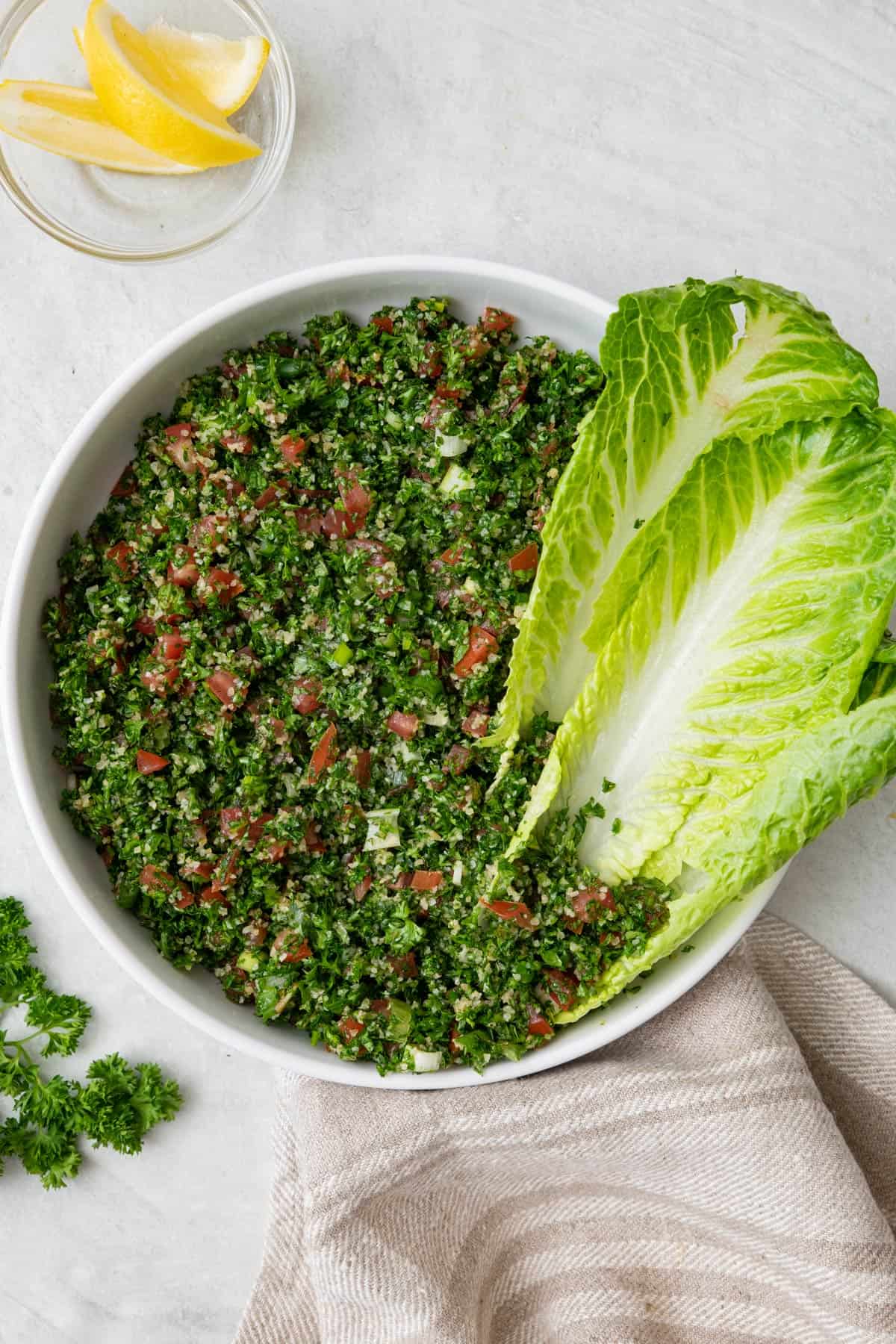
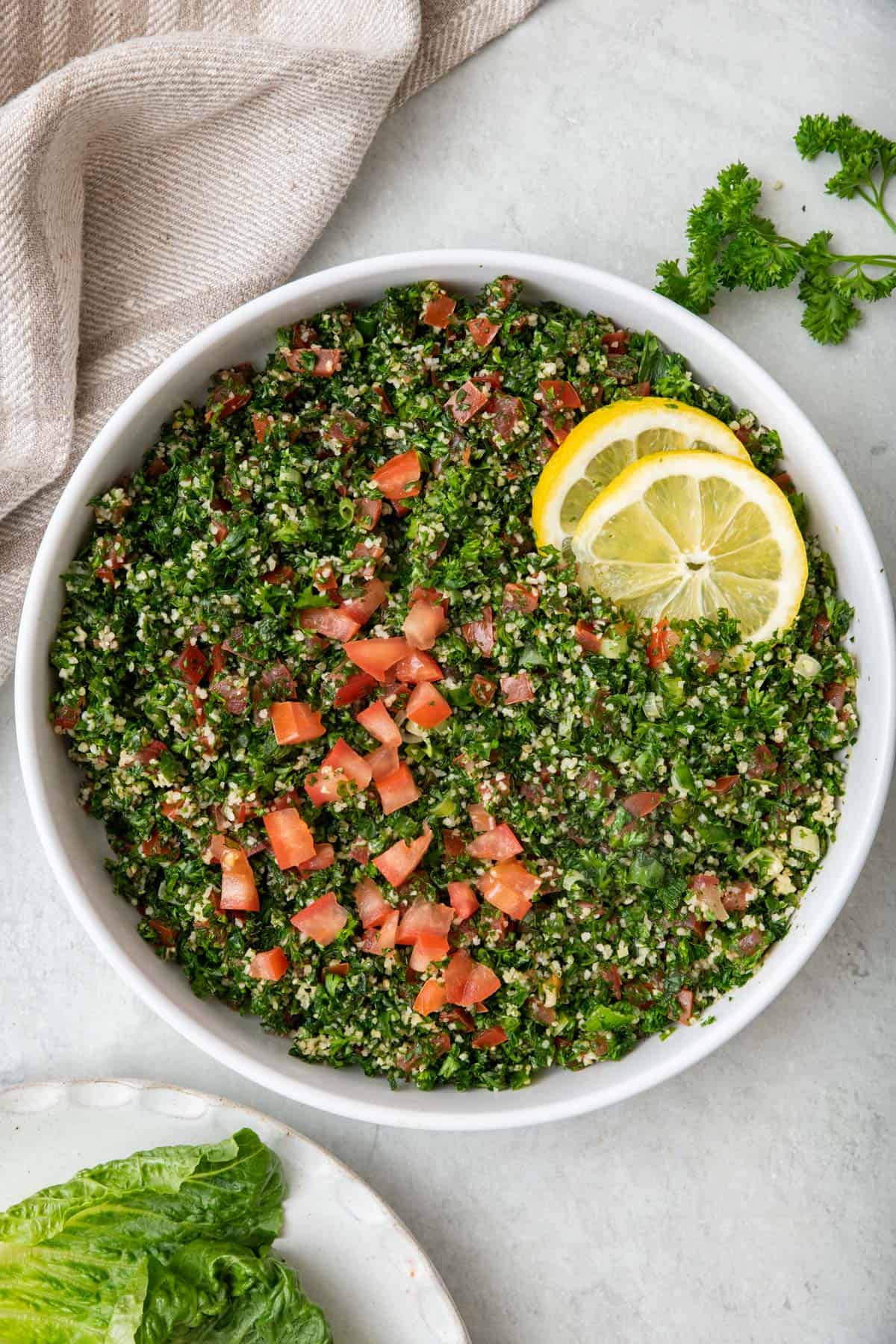






Comments
When you say 3 cups packed parsley do you measure it after chopping or before? I measured it after but I think I have too much parsley.
You should start with three bunches and once you chop just the leaves you should be left with roughly 3 packed cups.
Excellent. Thank you so much for a tasty easy-to-prepare small dinner salad. Would have to drive 3 hours round trip to find a restaurant that served tabbouleh or a store that sells bulgur wheat. Live on a small farm in rural Texas. Got my bulgur wheat from Amazon. Substituted fresh key lime juice for lemon, sea salt for salt, quartered Mexican cherry tomatoes for finely chopped tomatoes, fresh mint from garden. Will definitely make this recipe again as a side next time I make mesquite grilled pork souvlaki. Next recipe I’m fixin’ to make from y’all will be Black Bean Quesadillas. Already saved it.
Thank you, Richard! So happy you liked it and can’t wait to hear what you think about my Black Bean Quesadillas!!
This is hands down the best and most authentic tabbouleh recipe I have come across. My dad’s bet friend is from Turkey and says this reminds him of home. I use a little more lemon than what the recipe calls for for that extra fresh taste and it’s a grand slam. I could eat this with fresh pita and hummus all day. Thank you for not putting cucumbers in it as that is so not traditional.
Aww, thank you so much!! I’m so happy you enjoyed it!
Loved loved this recipe. So easy, tasty, healthy, and it gets better the next day. I made it with Quinoa and made it twice. This is a keeper. Thank you for this easy to make and yet very authentic healthy tabbouli 😍
Aww, so happy you liked it!! Thank you so much!
Do you have to cook the quinoa first?
Yes, if you substitute quinoa you do need to cook it first.
I’m using your recipe to refresh my memory since I haven’t made tabbouleh is a long time. When I tap double or triple the recipe to make larger quantities, on the parsley it says 3 packed cups for 1x, 2x and 3x even though the bunches of parsley obviously are more. I think you forgot to change that part! Thank you for this recipe I’m making food for 30+ people
Hi Lili! Unfortunately, I can’t edit the details of ingredients to adjust with the 2X and 3X buttons. If doubling, you should use 6 packed cups. If tripling, use 12. Hope you enjoy!!
Really great tip using the oil and lemon for the bulgar. Great recipe, thank you!
Thank you, Sadie! So happy you liked it!!
I grew up in Dearborn, MI and this is a proper recipe. Paired with some homemade pita and kibbeh brings me back.
Aww, so happy it brought you back!! Thank you so much, Bryan!
Three bunches of parley is about 8 cups of parsley, I suggest you remove bunches and just keep 3 cups. 😊
It’s hard to measure it by bunches because the bunches at my grocery store are smaller than the ones at my mom’s grocery store. I recommend measuring 3 packed cups, however many bunches that is for you. Hope that helps!
You said on your “Note” to make sure the bulgur does not require cooking for this recipe. I bought a package that does have a preparation instruction at the back of the bag. So not sure if what I have needs to be cooked or can be used straight away. Should I just mix it with olive oil-lemon mixture? Thank you
Hi Rowelo! If you purchased fine #1 bulgur, it shouldn’t need to be cooked. Coarser bulgur does need to be cooked though. Is it possible you bought coarse bulgur?
I tried this and went step by step being careful to follow your instructions. The bulgur stays hard even after I left it for 30 mins, hard as a rock. I need better instructions for bulgur to make it edible
Hi there! Did you use extra fine (#1) bulgur? Coarser bulgur does not work for this recipe.
See All Comments